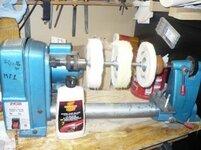Try different methods
I think that everyone develops their own process over time. You pick things up from others but once you find what works for you, it will almost become a ritual. Like a ball player wearing a lucky pair of dirty socks.
For me, the corner stone of a good finish is the sanding of the raw blank. The smoother the sanded blank is, the better the finished blank will become. I usually start with Micro Mesh. If I have metal inlay, I'll start with 320 to get a clean edge on the metal. Otherwise, if I have a mark that the MM won't remove, I go back and clean it up with a skew. I don't like to start with regular paper because it's residue dulls my MM and my tools.
For wood I go 1500, 1800, 2400, 3200, 3600 sanding with the grain only and never turning the lathe on. I find it redundant to put circular scratches on the surface only to remove them by sanding with the grain later. It doesn't seem to accomplish anything for me except take up more time.
When I get to the polishing grits 4000, 6000, 8000 & 12000, I power up the lathe to reduce the labor and achieve higher polish. The speed is probably around 700 RPM. I go back after each polishing grit and lightly sand lengthwise. I'm not sure it's necessary because I can't see a difference with my naked eye. But I do it anyway because I've been working with wood for so long that my conscience won't let me skip it.
Before I apply CA, I clean up the blank with accelerator and let it thoroughly dry. Then I apply CA (no BLO) with the lathe turning at about 500 RPM letting the glue dry between coats. 4 or 5 coats of "woodenwonders" medium is probably the norm for me. I don't really count the coats, I go more by how it looks. Then I do a cursory run through of the MM sanding grits just to remove any obvious bumps or ridges. Next I apply another coat or two of thick CA lengthwise with a piece of a foam makeup application wedge that I get at the local drug store. I can't use the stuff with the lathe running or it will react with the CA and get very hot, very quickly and screw up my work and burn my finger. But with the power off, it's really great at flowing that last coat or two of thick with out leaving much sanding work and giving the finish good depth. Then I pull it off of the lathe and let it hang on a bolt overnight to dry completely.
When I come back to it, I check for any drips. I get them sometimes if I put the last coat on too thick. If I find any, I remove them on the lathe with a careful use of a skew. Then I follow the same MM routine as described above. I make sure I have all the shiny spots removed by the 1800 grit. I don't have to wet sand because hand sanding doesn't build up enough heat to melt the CA. By doing this, the MM has more cut and it actually saves time.
I finish with an application of Meguire's ScratchX 2.0. I'm told that Nova 2.0 is even better than Mequire's but I've never tried it. I've tried Brasso but it has an abrasive in it that is actually coarser than the MM finish so IMO the result is duller than what I started with.
This process works for me every time. By making sure the accelerator is completely dry and not using any water, the chances of the CA getting any cloudy areas is eliminated. It really doesn't take as long as it would seem from reading this. Except for the drying time, I think it took me longer to write it down than it does to do the process from start to finish and I type 50WPM.

